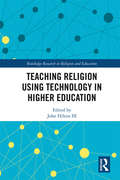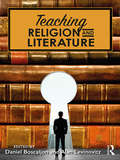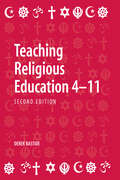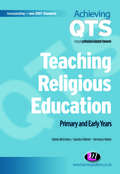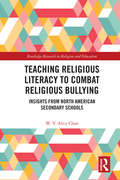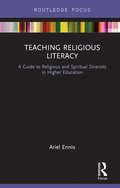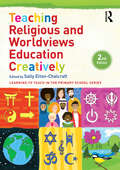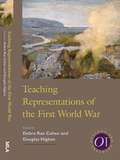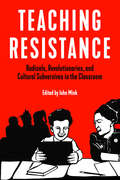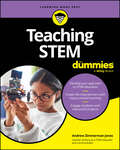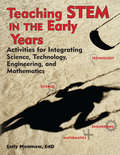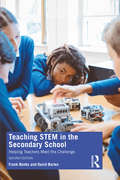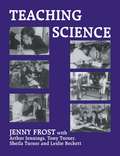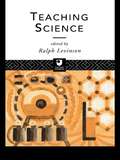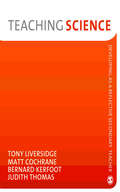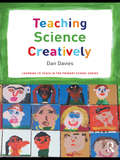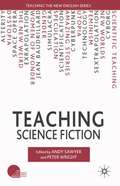- Table View
- List View
Teaching Religion Using Technology in Higher Education (Routledge Research in Religion and Education)
by John Hilton IIIThis edited collection helps those teaching religion in higher education utilize technology to increase student learning both inside and outside of the classroom. Recent times have seen major technological shifts that have important implications for how religion is taught at a post-secondary level. Providing multiple perspectives on a range of topics—including social media use and interactive classroom learning —this book presents a series of original case studies and insights on how technology can be used in religion classes in higher education to improve student learning.
Teaching Religion and Literature
by Daniel Boscaljon Alan LevinovitzTeaching Religion and Literature provides a practical engagement with the pedagogical possibilities of teaching religion courses using literature, teaching literature classes using religion, and teaching Religion and Literature as a discipline. Featuring chapters written by award winning teachers from a variety of institutional settings, the book gives anyone interested in providing interdisciplinary education a set of questions, resources, and tools that will deepen a classroom’s engagement with the field. Chapters are grounded in specific texts and religious questions but are oriented toward engaging general pedagogical issues that allow each chapter to improve any instructor’s engagement with interdisciplinary education. The book offers resources to instructors new to teaching Religion and Literature and provides definitions of what the field means from senior scholars in the field. Featuring a wide range of religious traditions, genres, and approaches, the book also provides an innovative glimpse at emerging possibilities for the sub-discipline.
Teaching Religion and Science: Effective Pedagogy and Practical Approaches for RE Teachers
by Geoff Teece Tonie StolbergCan religion and science co-exist successfully in the classroom? How can you encourage an environment where differing views are treated positively? How do you help students apply their understanding of religious beliefs and scientific theory to a range of ultimate questions? Teaching Religion and Science aims to give RE teachers a pedagogical foundation for the teaching of religion and science topics, and for the teaching of religion as a whole. It will help you to have confidence to include what might appear to be challenging or controversial topics in your lessons, and provides guidance on how religion and science themes can be effectively addressed using appropriate classroom teaching methods. Containing a wealth of practical advice to help you turn pedagogical theory into practice effortlessly, it helps you understand your own attitudes to the subject, as well as those of your students, to ensure successful teaching. Essential guidance includes: activities to help you apply pedagogic practices to your own particular classroom situation advice to help minimise potential difficulties whilst tackling controversial issues links to a wide range of resources and advice on further reading comprehensive lesson plans for ages 11-16 and 16-19. Designed to be a resource for all training and practising R.E. teachers, Teaching Religion and Science offers much needed support for successfully integrating the teaching of religion and science in your classroom.
Teaching Religious Education 4-11
by Derek BastideThis long-awaited second edition is an accessible, practical guide for primary teachers. It covers the teaching of religious education at the Foundation Stage, Key Stage 1 and Key Stage 2. Taking account of the changes to RE over the last decade, it maps out and considers the implications for teachers of: changes that have taken place over the last few years with regard to changing aims and objectives in the subject the legal framework the broadening understanding of the notion of religion concern for spiritual development emergence of citizenship as an additional component of the curriculum introduction of formal guidelines to the content of RE teaching Christianity and other world faiths tackling important topics and contemporary issues planning RE across the primary school planning a unit of work using different teaching approaches monitoring and assessing progress. The book is full of practical examples and will also contain a uesful resources section. In addition there will be a chapter on key religions, which will look at Buddhism, Christianity, Hinduism, Islam, Judaism and Sikhism.
Teaching Religious Education Creatively
by Sally Elton-ChalcraftTeaching Religious Education Creatively offers a brand new approach for the primary classroom and is crammed full of innovative ideas for bringing the teaching of RE to life. It helps teachers understand what constitutes a healthy curriculum that will encourage children to appreciate and understand different belief systems. Perhaps most importantly, it also challenges teachers to understand RE as a transformatory subject that offers children the tools to be discerning, to work out their own beliefs and answer puzzling questions. Underpinned by the latest research and theory and with contemporary, cutting-edge practice at the forefront, expert authors emphasise creative thinking strategies and teaching creatively. Key topics explored include: What is creative teaching and learning? Why is it important to teach creatively and teach for creativity? What is Religious Education? Why is it important for children to learn ‘about’ and ‘from’ religion? How can you teach non-biased RE creatively as a discrete subject and integrate it with other curriculum areas?? Teaching Religious Education Creatively is for all teachers who want to learn more about innovative teaching and learning in RE in order to improve understanding and enjoyment and transform their own as well as their pupil’s lives.
Teaching Religious Education: Primary and Early Years (Achieving QTS Series)
by Sandra Palmer Veronica M Voiels Elaine McCreeryMany trainee primary teachers are uncertain as to the place and purpose of RE in primary schools. This book is designed to alleviate such fears and give trainees the security and confidence to teach RE effectively. Trainees are encouraged to recognise their own religious position and understand how they handle their own beliefs and commitments in the classroom. In addition, they will learn how to be sensitive to children′s religious viewpoints, allowing children to share their beliefs in a secure and supportive environment. A range of strategies help readers to provide engaging and appropriate RE across the primary age phase.
Teaching Religious Literacy to Combat Religious Bullying: Insights from North American Secondary Schools (Routledge Research in Religion and Education)
by W. Y. ChanThis text explores the phenomenon of religious bullying as it manifests in two North American contexts and theorizes religious literacy as a viable school-based intervention to promote understanding of religious and non-religious difference. Using substantive, qualitative data from schools and communities in California and Quebec, Teaching Religious Literacy to Combat Religious Bullying examines the impact of mandatory religious literacy courses delivered in secondary schools and identifies curricula, teacher attitudes, training, and administrative support as key determinants of course impact. Drawing on Bronfenbrenner’s social-ecological framework, the text then illustrates how the environmental factors both in and outside of the school considerably influence teacher and student attitudes to religious and non-religious traditions. Practical recommendations are made to combat overarching societal trends and religious discrimination within the classroom, and context is cited as key to an effective discussion on religious literacy more broadly. This text will benefit researchers, academics, and educators with an interest in religious literacy, religious education, the sociology of education, and those looking at the field of bullying and truancy more widely. Those interested in intersectionality, marginalized communities, secularism, and educational policy will also benefit from the volume.
Teaching Religious Literacy: A Guide to Religious and Spiritual Diversity in Higher Education
by Ariel EnnisOffering resources and initiatives on religious and spiritual diversity in higher education, this book describes the conceptual foundations for teaching religious literacy and provides a sample curriculum with a facilitator's guide and assessment tools needed to evaluate its development among students. With a clear understanding of the diversity of religious and spiritual experiences found on college and university campuses, Ennis offers a much-needed framework for facilitating conversations about religion and spirituality in colleges and universities. By working from a comprehensive overview of NYU’s award-winning Faith Zone training program, this book breaks down the methodology and tools required to create religious literacy training curricula at campuses around the world.
Teaching Religious and Worldviews Education Creatively (Learning to Teach in the Primary School Series)
by Sally Elton-ChalcraftTeaching Religious and Worldviews Education Creatively offers a fresh perspective on the Religious Education (RE) curriculum. This second edition is crammed full of practical lesson ideas underpinned by cutting edge research authored by specialists in the field. It helps teachers understand what constitutes an effective and creative Religion and Worldviews Education (RWE) curriculum, and challenges teachers to view RWE as a transformatory subject that offers learners the tools to be discerning, to work out their own beliefs and to answer puzzling questions.This second edition of Teaching Religious and Worldviews Education Creatively includes fully updated chapters from the first edition with 11 new contributors and 5 brand new chapters. New topics include:- Visits, visitors and persona dolls- The RE Searchers approach- New ideas about policy, practice and assessment- Insights into RE in the UK and around the world- Anti-discriminatory RE- New and updated practical classroom ideas from practicing teachersTeaching Religious and Worldviews Education Creatively is for all teachers who want to learn more about innovative teaching and learning in RWE in order to improve understanding, knowledge and enjoyment, while at the same time transforming their own as well as their pupils’ lives.
Teaching Representations of the First World War (Options for Teaching #41)
by Debra Rae Cohen Douglas HigbeeThe First World War saw staggering loss of life and was a catalyst for many political and social changes. It was also shaped by the media and art forms that expressed it: film, photography, poetry, memoir, posters, advertisements, and music. This volume's scope shows that today's instructors contend with many different issues in teaching the First World War in a variety of classroom settings. Among these issues are the war's relation to modernism; global reach in the Middle East and South Asia; influence on psychiatry, pacifism, and consumer culture; and effect on public health and the 1918 influenza pandemic.
Teaching Representations of the French Revolution (Options for Teaching #47)
by Julia Douthwaite Viglione, Antoinette Sol, and Catriona SethIn many ways the French Revolution--a series of revolutions, in fact, whose end has arguably not yet arrived--is modernity in action. Beginning in reform, it blossomed into wholesale attempts to remake society, uprooting the clergy and aristocracy, valorizing mass movements, and setting secular ideologies, including nationalism, in motion. Unusually manifold and complicated, the revolution affords many teaching opportunities and challenges. This volume helps instructors seeking to connect developments today--terrorism, propaganda, extremism--with the events that began in 1789, contextualizing for students a world that seems always unmoored and in crisis.The volume supports the teaching of the revolution's ongoing project across geographic areas (from Haiti, Latin America, and New Orleans to Spain, Germany, and Greece), governing ideologies (human rights, secularism, liberty), and literatures (from well-known to newly rediscovered texts). Interdisciplinary, intercultural, and insurgent, the volume has an energy that reflects its subject.
Teaching Resilience and Mental Health Across the Curriculum: A Guide for High School and College Teachers
by Linda Yaron WestonWritten by a teacher for teachers, Teaching Resilience and Mental Health Across the Curriculum is an integrative approach to pedagogy for educators at the high school and college level to survive, thrive, and sustain in the profession. Blending theory, research, and practice for a comprehensive program for teachers to incorporate well-being tools into the classroom, each of the book’s five foundations includes engaging information, strategies, real-world examples, interactive reflection questions, and activities that can be directly applied to teaching and life. Practical guidance in designing real-world curriculum is offered alongside accessible strategies for engagement, investment, and active learning in student-centered classrooms. An essential guide for teachers, it includes techniques for incorporating well-being that are grounded in culturally responsive teaching, trauma-informed instruction, mental health, resilience, and emotional literacy. Teachers will also gain insight on how to make the career sustainable through practices for self-compassion and authentic self-care so they can not only survive, but flourish in and out of school. For all the challenges that students and teachers face, this book defines what it means, and what it takes, to teach in today’s classrooms.
Teaching Resistance: Radicals, Revolutionaries, and Cultural Subversives in the Classroom
by John MinkTeaching Resistance is a collection of the voices of activist educators from around the world who engage inside and outside the classroom from pre-kindergarten to university and emphasize teaching radical practice from the field. Written in accessible language, this book is for anyone who wants to explore new ways to subvert educational systems and institutions, transform educational spaces, and empower students and teachers to fight for genuine change. Topics include community self-defense, Black Lives Matter and critical race theory, intersections between punk/DIY subculture and teaching, ESL, anarchist education, Palestinian resistance, trauma, working-class education, prison teaching, the resurgence of (and resistance to) the Far Right, special education, antifascist pedagogies, and more. Edited by social studies teacher, author, and punk musician John Mink, the book features expanded entries from the monthly column in the politically insurgent punk magazine Maximum Rocknroll, plus new works and interviews with subversive educators. Contributing teachers include Michelle Cruz Gonzales, Dwayne Dixon, Martín Sorrondeguy, Alice Bag, Miriam Klein Stahl, Ron Scapp, Kadijah Means, Mimi Nguyen, Murad Tamini, Yvette Felarca, Jessica Mills, and others.
Teaching Resistant Learners in Post-School Education: A Guide to Working with Challenging Behaviour
by Merv LeborThis book explores various frameworks within which post-school education is situated and the practice that actually happens in classrooms and lecture theatres, especially when things go wrong. Examining how and why some students choose to resist learning whilst undertaking tertiary education, this book provides practical tips and guidance for educators on how to work through difficult situations where learning isn’t a student’s priority. Considering both theory and practice, the book offers a range of practical solutions to difficult circumstances, such as the greater emphasis on distance learning, the growth of predatory or fake journals to the challenges of too much screen time, ghostwriters and plagiarism, speaking out of turn, consistent lateness, absenteeism and even violent behaviour. Looking at contexts and behaviours where learning is rejected or ignored, through students’ indifference or resistance, from a range of perspectives, this book is ideal reading for anyone working or involved in tertiary education, including teacher trainees, tutors, teacher educators, managers, administrators and lecturers working at universities and colleges, as well as students who may benefit from discussions of the problematic nature of learning.
Teaching STEAM Through Hands-On Crafts: Real-World Maker Lessons for Grades 3-8
by Amanda Haynes Christine G. SchnittkaHelp your students connect historic technologies with today’s STEAM concepts through the lens of crafting! This book, written by a science education professor and a middle school STEM teacher, provides guidance for turning classic crafts into transdisciplinary STEAM lessons for grades 3–8. Ready-to-use lessons outline the history, science, mathematics, and engineering embedded within ten hands-on crafts from around the world. Each chapter outlines the history of a craft, its social impact, and the mathematics, engineering, and scientific concepts and skills embedded in the craft. Content standards from art, history, English language arts, technology, mathematics, and science are embedded within each unit. Lessons are supplemented with ready-to-photocopy handouts, guiding questions, and logistical support such as shopping lists and safety procedures. Activities have all been classroom-tested to ensure appropriate leveling and applicability across STEAM disciplines. Ideal for any STEM or STEAM classroom across upper elementary and middle schools, this book helps make STEM concepts meaningful and tangible for your students. Rather than just reading about science, technology, mathematics, or engineering, students will become makers and engage in STEAM directly, just as original crafters have done for centuries.Additional instructional materials are available at: https://steamcrafts.weebly.com/
Teaching STEM For Dummies
by Andrew Zimmerman JonesSpark a passion for STEM Teaching STEM For Dummies is an easy-to-read and exciting new guide for teachers who want to inspire their students with engaging lessons and thoughtful discussions about science, technology, engineering, and mathematics. This practical roadmap to developing hands-on classroom material relevant to the real world shows you how to define STEM topics and overcome the most common challenges to teaching these complex subjects to younger students. You'll learn how you can make STEM more welcoming—using inclusion, scaffolding, and differentiation—and discover resources for STEM teachers you can deploy immediately in your classroom. Inside the book: Understand the STEM concepts students are expected to learn at different grades and how to connect those ideas together in engaging lessons Teach your students the inquisitive mindsets, logical reasoning, and collaboration skills they'll need to succeed in STEM fields Increase STEM inclusivity in both the classroom and the industry by engaging all students in STEM from early ages Discover resources to educate students on the problem-solving concepts at the core of STEM subjects Perfect for teachers, homeschooling parents, tutors, and other educators, Teaching STEM For Dummies is a can't-miss read for anyone who wants to open young minds to the wonders of STEM.
Teaching STEM in the Early Years
by Sally MoomawThe foundation for science, technology, engineering, and mathematics (STEM) education begins in the early years. This book provides more than ninety activities and learning center ideas that seamlessly integrate STEM throughout early childhood classrooms. These hands-on STEM experiences enhance cooking, art, and music activities, block play and sensory table exploration, and field trips and outdoor time. Information on assessment and early learning standards is also provided.Sally Moomaw, EdD, has spent much of her career researching and teaching STEM education. She is an assistant professor at the University of Cincinnati and the author of several early education books.
Teaching STEM in the Secondary School: Helping Teachers Meet The Challenge
by David Barlex Frank BanksThis book looks at the purpose and pedagogy of STEM teaching and explores the ways in which STEM subjects can interact in the curriculum to enhance student understanding, achievement and motivation. By reaching outside their own classroom, teachers can collaborate across STEM subjects to enrich learning and help students relate school science, technology and maths to the wider world. Packed with ideas and practical details for teachers of STEM subjects, the new revised edition of this book: ■ considers what the STEM subjects contribute separately to the curriculum and how they relate to each other in the wider education of secondary school students; ■ describes and evaluates different curriculum models for STEM; ■ suggests ways in which a critical approach to the pedagogy of the classroom, laboratory and workshop can support and encourage all pupils to engage fully in STEM; ■ addresses the practicalities of introducing, organising and sustaining STEM-related activities in the secondary school; ■ looks to ways schools can manage and sustain STEM approaches in the long-term. This new revised edition is essential reading for trainee and practising teachers, those engaged in further professional development and all who wish to make the learning of science, technology, engineering and mathematics an interesting, motivating and exciting experience for their students.
Teaching STEM in the Secondary School: Helping teachers meet the challenge
by David Barlex Frank BanksThe skills, knowledge and understanding of the subjects involved in STEM (Science, Technology, Engineering and Mathematics) are vital for all young people in an increasingly science- and technology-driven society. This book looks at the purpose and pedagogy of STEM teaching and explores the ways in which STEM subjects can interact in the curriculum to enhance student understanding, achievement and motivation. By reaching outside their own classroom, teachers can collaborate across subjects to enrich learning and help students relate school science, technology and maths to the wider world. Packed with ideas and practical details for teachers of STEM subjects, this book: considers what the STEM subjects contribute separately to the curriculum and how they relate to each other in the wider education of secondary school students describes and evaluates different curriculum models for STEM suggests ways in which a critical approach to the pedagogy of the classroom, laboratory and workshop can support STEM for all students addresses the practicalities of introducing, organising and sustaining STEM-related activities in the secondary school looks to ways schools can manage and sustain STEM approaches in the long-term. This timely new text is essential reading for trainee and practising teachers who wish to make the learning of Science, Technology, Engineering and Mathematics an interesting, motivating and exciting experience for their students.
Teaching Science
by Jenny Frost Richard B. IngleFirst published in 1995. Routledge is an imprint of Taylor & Francis, an informa company.
Teaching Science
by Ralph LevinsonScience education has undergone far-reaching changes in the last fifty years. The articles collected together in this reader examine how we have reached our present consensus and what theories we now use to explain how children learn science. The central sections of the reader examine how all this can be translated into effective and stimulating teaching, how learning can be most accurately and fairly assessed and how the impact of gender, ethnicity and other factors on children's performance can be addressed in methods of teaching which make science accessible to all. The articles in the final section of the book are a reminder that the debate is not finished yet and raise some challenging questions about what science education is and what it is for.
Teaching Science (Developing as a Reflective Secondary Teacher)
by Judith Thomas Matt Cochrane Mr Bernard Kerfoot Dr Tony LiversidgeReflective practice is at the heart of effective teaching, and this book helps you develop into a reflective teacher of Science. Everything you need is here: guidance on developing your analysis and self-evaluation skills, the knowledge of what you are trying to achieve and why, and examples of how experienced teachers deliver successful lessons. It includes advice about obtaining your first teaching post, and about continuing professional development. The book shows you how to plan creative lessons, how to make good use of resources and how to assess pupils' progress effectively. Each chapter contains points for reflection, which encourage you to break off from your reading and think about the challenging questions that you face as a new teacher. The book comes with access to a companion website, www.sagepub.co.uk/secondary, where you will find: - Videos of real lessons so you can see the skills discussed in the text in action - Links to a range of sites that provide useful additional support - Extra planning and resource materials. If you are training to teach science this book will help you to improve your classroom performance, by providing you with practical advice, but also by helping you to think in depth about the key issues. It also supplements guidance on undertaking a research project with examples of the research evidence that is needed in academic work at Masters level, essential for anyone undertaking an M-level PGCE.
Teaching Science Creatively
by Dan Davies Deb McGregorHow can you unlock your own creativity to help children learn science creatively? How do you bring the world of ‘real science’ into the classroom? Where does science fit in a creative curriculum? Teaching Science Creatively explores how creative teaching can harness primary-aged children’s sense of wonder about the world around them. It offers innovative starting points to enhance your teaching and highlights curiosity, observation, exploration and enquiry as central components of children’s creative learning in science. Illustrated throughout with examples from the classroom and beyond, this book explores the core elements of creative practice supporting both teacher and children to develop their knowledge and skills. Key themes include: The importance of science in a creative primary curriculum The role of play in early scientific learning Developing children’s own interests and ideas into creative enquiry How theories of learning can help you understand children’s creative development Teaching science topics in innovative and creative ways - games, drama, role play, puppets, mini-safaris and welly walks! Using new technologies to enhance your science teaching in the classroom and outdoors Stimulating and accessible, with contemporary and cutting-edge practice at the forefront, Teaching Science Creatively introduces new ideas to support and motivate new and experienced primary teachers. It is an essential purchase for any professional who wishes to incorporate creative approaches to teaching science in their classroom.
Teaching Science Creatively (Learning to Teach in the Primary School Series)
by Dan Davies Deb McGregorHow can you unlock your own creativity to help children learn science creatively? How do you bring the world of ‘real science’ into the classroom? Where does science fit in a creative curriculum? This second edition of Teaching Science Creatively has been fully updated to reflect new research, initiatives and developments in the field. It offers innovative starting points to enhance your teaching and highlights curiosity, observation, exploration and enquiry as central components of children’s creative learning in science. Illustrated throughout with examples from the classroom and beyond, the book explores how creative teaching can harness children’s sense of wonder about the world around them. With easily accessible chapters, it offers a comprehensive introduction to the core elements of creative science learning, supporting both teacher and child in developing scientific concepts and skills. The book explores key issues such as: • the links between scientific and creative processes• how to teach creatively, and for creativity• the role of play in early scientific learning• developing scientific understanding through drama (new)• using the outdoors in science• how theories of learning relate to children’s creative development• teaching science topics in innovative and creative ways – games, drama, role play, puppets, mini-safaris and welly walks! Stimulating and accessible, with contemporary and cutting-edge practice at the forefront, Teaching Science Creatively introduces fresh ideas to support and motivate both new and experienced primary teachers. It is an essential purchase for any professional who wishes to incorporate creative approaches to teaching science in their classroom.
Teaching Science Fiction
by Peter Wright Andy SawyerTeaching Science Fiction is the first text in thirty years to explore the pedagogic potential of that most intellectually stimulating and provocative form of popular literature: science fiction. Innovative and academically lively, it offers valuable insights into how SF can be taught historically, culturally and practically at university level.
